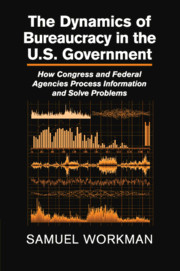 The Dynamics of Bureaucracy in the US Government
The Dynamics of Bureaucracy in the US Government Published online by Cambridge University Press: 05 May 2015
“In fact, organizations can be remarkably effective devices for working out difficult public problems. … Formal authority travels from top to bottom in organizations, but the informal authority that derives from expertise, skill, and proximity to the essential tasks that an organization performs travels in the opposite direction … this means that formal authority, in the form of policy statements, is heavily dependent upon specialized problem-solving capabilities further down the chain of authority.”
– Richard F. Elmore (1979, p. 606)WHAT IS THIS BOOK ABOUT?
This book develops a theory of dual dynamics within the administrative state in the United States. Agenda setting in the administrative state is characterized by the dual dynamics of information provision and communication by the bureaucracy and simultaneous “tuning” of this information supply by Congress. Bureaucratic problem solving generates a flow of information to Congress as bureaucracies monitor the agenda for potential problems, define these problems for action at higher levels of government, and transmit information pursuant to these definitions. The information supply generated by bureaucracy both influences and informs congressional problem prioritization such as efforts to shape that supply through issue shuffling, issue bundling, and congressional manipulation of bureaucratic competition in the provision of information.
By developing and extending systems and communications frameworks to the study of bureaucracy, I lay out an explanation of agenda setting in the United States as a product of a communications system characterized by feedback and the competitive provision of information in steering problem definitions. It subsumes classical top-down, preference-driven approaches in a more complete explanation of agenda setting in the administrative state.
The empirical foundation of the book is a dataset comprising the policymaking agenda of the entire federal bureaucracy over a quarter-century. The dataset is enormous, containing 226,710 regulations issued by all bureaucracies in the federal government since the early 1980s. In addition, this dataset is unique, having no peer in academia, the public sector, or elsewhere: it is the first and only of its kind. Collecting, organizing, and coding the data represented an enormous outlay of time and effort.
To save this book to your Kindle, first ensure [email protected] is added to your Approved Personal Document E-mail List under your Personal Document Settings on the Manage Your Content and Devices page of your Amazon account. Then enter the ‘name’ part of your Kindle email address below. Find out more about saving to your Kindle.
Note you can select to save to either the @free.kindle.com or @kindle.com variations. ‘@free.kindle.com’ emails are free but can only be saved to your device when it is connected to wi-fi. ‘@kindle.com’ emails can be delivered even when you are not connected to wi-fi, but note that service fees apply.
Find out more about the Kindle Personal Document Service.
To save content items to your account, please confirm that you agree to abide by our usage policies. If this is the first time you use this feature, you will be asked to authorise Cambridge Core to connect with your account. Find out more about saving content to Dropbox.
To save content items to your account, please confirm that you agree to abide by our usage policies. If this is the first time you use this feature, you will be asked to authorise Cambridge Core to connect with your account. Find out more about saving content to Google Drive.